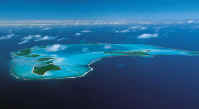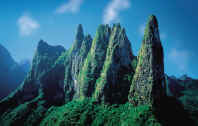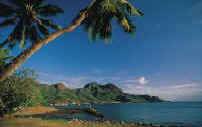





![]() Environment
Environment![]()
The 118
islands of French Polynesia are specks in the vast South Pacific Ocean.
They are  divided
into five groups: the Society Islands (which include Tahiti),
the Tuamotus, the Marquesas, the Australs and the
Gambiers. Only six of the islands are larger than 100 sq km,
and the northernmost island, Hatutu, is more than 2000km from the
southernmost island, Rapa. The nearest continental land masses are
Australia, 5200km to the west, and South America, 6000km to the east.
The territory's nearest Pacific neighbour is the Cook Islands, to the
west.
divided
into five groups: the Society Islands (which include Tahiti),
the Tuamotus, the Marquesas, the Australs and the
Gambiers. Only six of the islands are larger than 100 sq km,
and the northernmost island, Hatutu, is more than 2000km from the
southernmost island, Rapa. The nearest continental land masses are
Australia, 5200km to the west, and South America, 6000km to the east.
The territory's nearest Pacific neighbour is the Cook Islands, to the
west.
The
islands are a mixture of volcanic high islands and coral atolls. The
high islands have rich, fertile soil and support a much wider
diversity of vegetation than the atolls. Magnificent  Tahitian
tiare flowers grow abundantly on the high islands and these are
woven into leis (flowers necklaces) or worn in the hair. Many
introduced flora species exist in the region, including hibiscus and
bougainvillea. Most of the land-based creatures were introduced and
include wild pigs and fowl, semi-domesticated goats in the Marquesas,
and sheep on Tahiti, the Australs and the Marquesas. Small geckos
abound and there are large centipedes that have a decent sting. French
Polynesia has around 100 species of birds, including terns, petrels,
noddies and frigatebirds. The abundance and diversity of marine life
is immediately obvious when you poke you head underwater.
Tahitian
tiare flowers grow abundantly on the high islands and these are
woven into leis (flowers necklaces) or worn in the hair. Many
introduced flora species exist in the region, including hibiscus and
bougainvillea. Most of the land-based creatures were introduced and
include wild pigs and fowl, semi-domesticated goats in the Marquesas,
and sheep on Tahiti, the Australs and the Marquesas. Small geckos
abound and there are large centipedes that have a decent sting. French
Polynesia has around 100 species of birds, including terns, petrels,
noddies and frigatebirds. The abundance and diversity of marine life
is immediately obvious when you poke you head underwater.
French
Polynesia's tropical climate has two distinct seasons. The wet season,
between  November
and April, has average temperatures around 27░-30░C with high
humidity, ample rain (75% of the annual rainfall) and brief, violent
storms. The dry season, between May and October, has little rain,
drier air and slightly cooler temperatures. There are prevailing winds
which can blow with a force of 40 to 60km/h. The maraamu is a
south-easterly that is common in the dry season, and the toerau
is a north-north-easterly that blows occasionally in the wet season
November
and April, has average temperatures around 27░-30░C with high
humidity, ample rain (75% of the annual rainfall) and brief, violent
storms. The dry season, between May and October, has little rain,
drier air and slightly cooler temperatures. There are prevailing winds
which can blow with a force of 40 to 60km/h. The maraamu is a
south-easterly that is common in the dry season, and the toerau
is a north-north-easterly that blows occasionally in the wet season

![]()